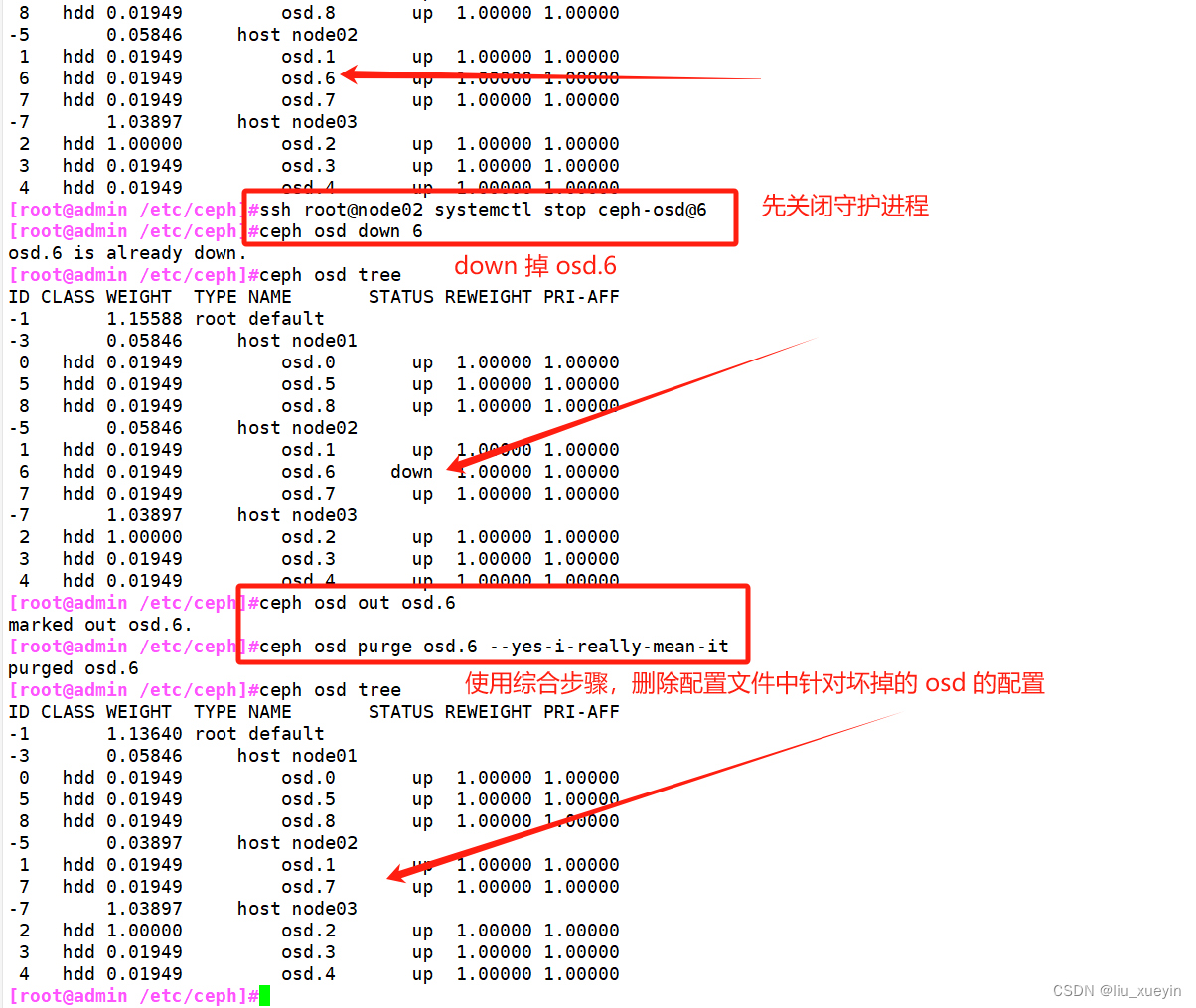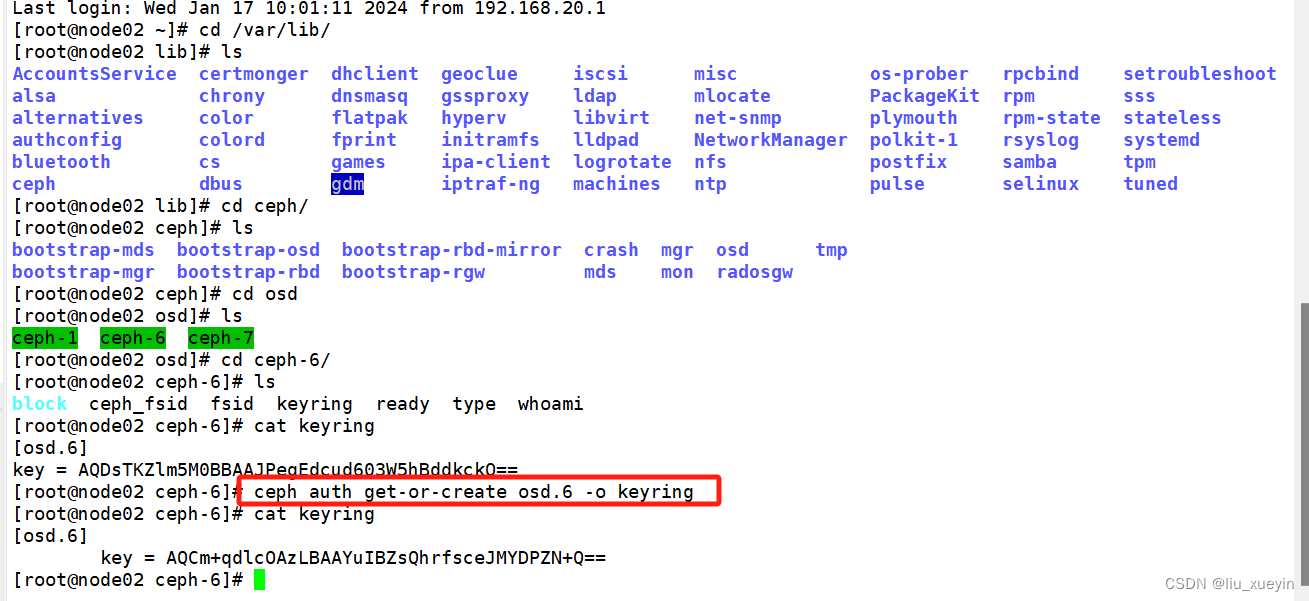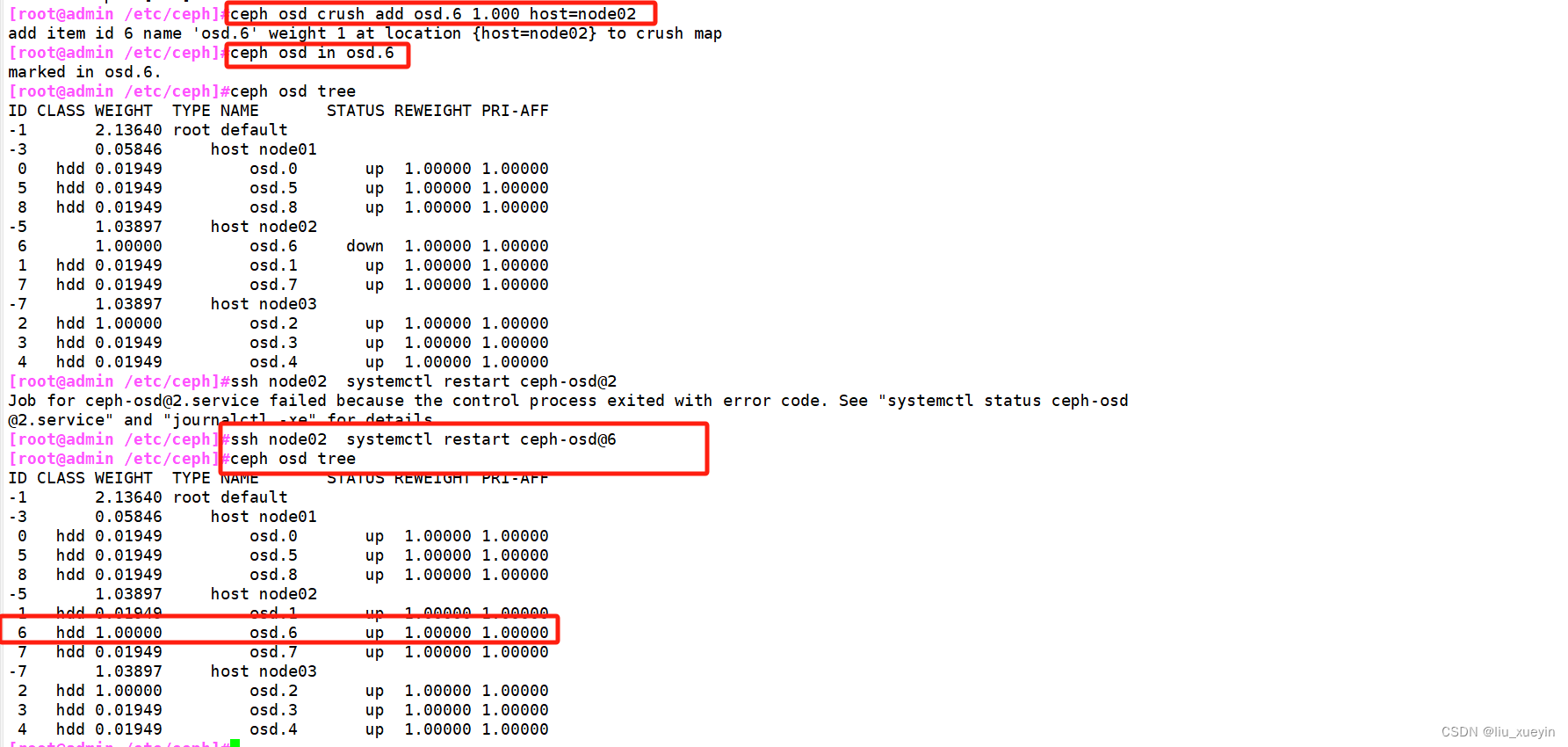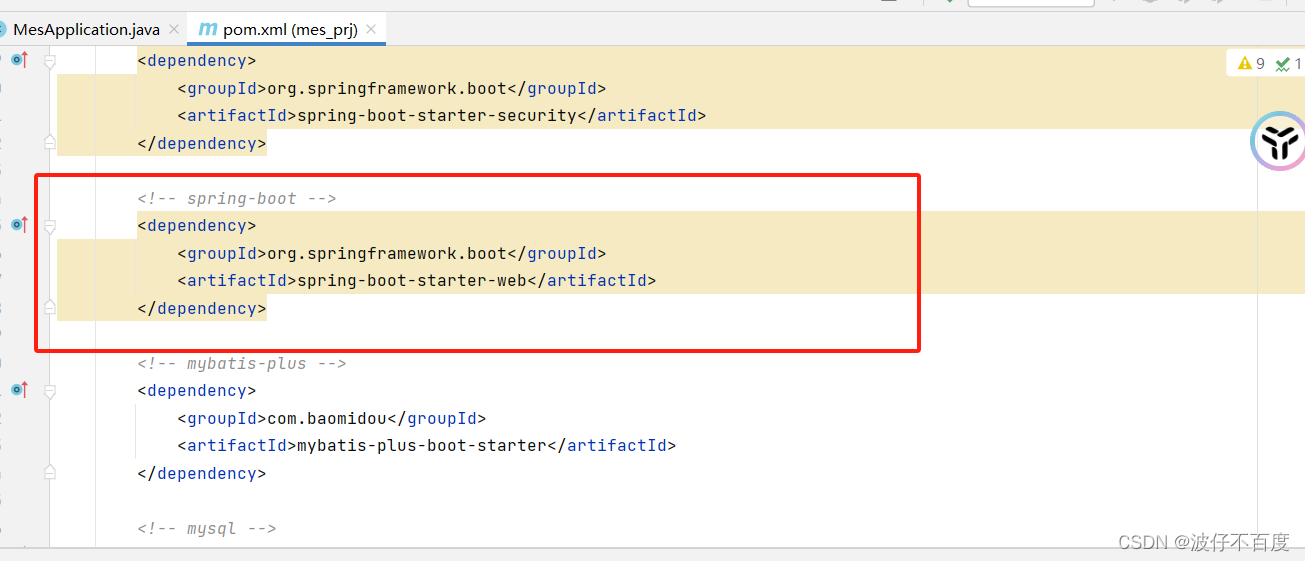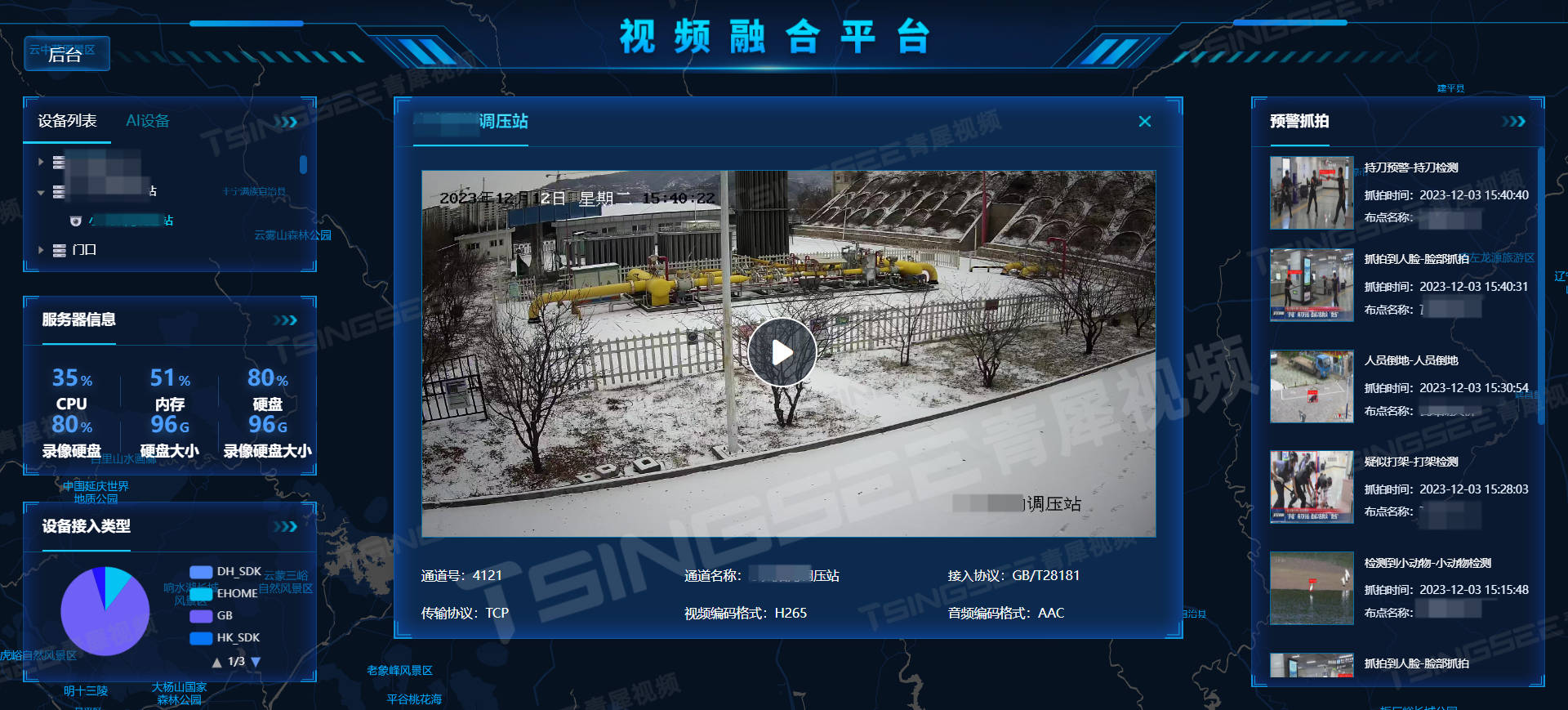目录
1、对象存储概念
2、创建 RGW 接口
//在管理节点创建一个 RGW 守护进程
#创建成功后默认情况下会自动创建一系列用于 RGW 的存储池
#默认情况下 RGW 监听 7480 号端口
//开启 http+https ,更改监听端口
#更改监听端口
//创建 RadosGW 账户
客户端测试
OSD 故障模拟与恢复
3、把原来坏掉的 osd 修复后重新加入集群
方法二
1、对象存储概念
对象存储(object storage)是非结构数据的存储方法,对象存储中每一条数据都作为单独的对象存储,拥有唯一的地址来识别数据对象,通常用于云计算环境中。
不同于其他数据存储方法,基于对象的存储不使用目录树。
虽然在设计与实现上有所区别,但大多数对象存储系统对外呈现的核心资源类型大同小异。从客户端的角度来看,分为以下几个逻辑单位:
●Amazon S3:
提供了
1、用户(User)
2、存储桶(Bucket)
3、对象(Object)
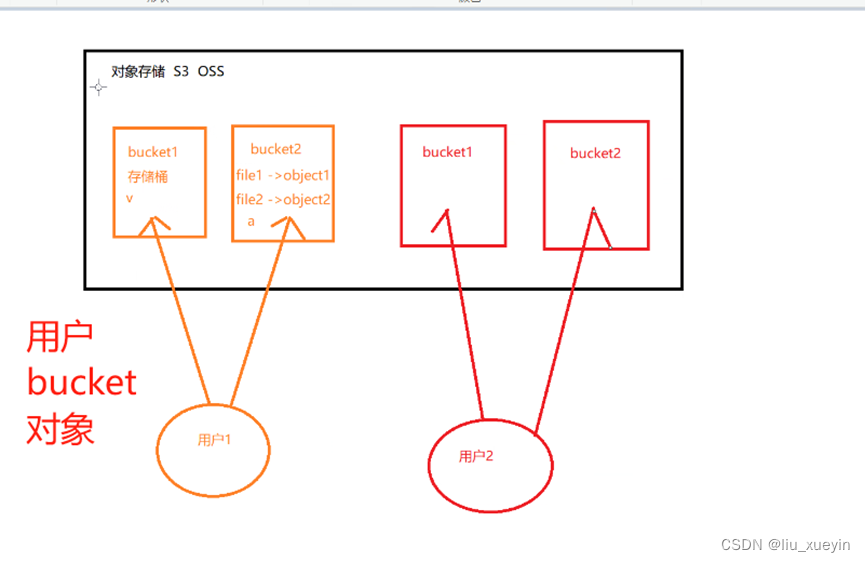
三者的关系是:
1、User将Object存储到系统上的Bucket
2、存储桶属于某个用户并可以容纳对象,一个存储桶用于存储多个对象
3、同一个用户可以拥有多个存储桶,不同用户允许使用相同名称的Bucket,因此User名称即可做为Bucket的名称空间
●OpenStack Swift:
提供了user、container和object分别对应于用户、存储桶和对象,不过它还额外为user提供了父级组件account,用于表示一个项目或用户组,因此一个account中可以包含一到多个user,它们可共享使用同一组container,并为container提供名称空间
●RadosGW:
提供了user、subuser、bucket和object,其中的user对应于S3的user,而subuser则对应于Swift的user,不过user和subuser都不支持为bucket提供名称空间,因此不同用户的存储桶不允许同名;不过,自jewel版本起,RadosGW引入了tenant(租户)用于为user和bucket提供名称空间,但他是个可选组件
从上可以看出大多数对象存储的核心资源类型大同小异,如 Amazon S3、OpenStack Swift 与 RadosGw。其中 S3 与 Swift 互不兼容,RadosGw 为了兼容 S3 与 Swift, Ceph 在 RadosGW 集群的基础上提供了 RGW(RadosGateway)数据抽象层和管理层,它可以原生兼容 S3 和 Swift 的 API。
S3和Swift它们可基于http或https完成数据交换,由RadosGW内建的Civetweb提供服务,它还可以支持代理服务器包括nginx、haproxy等以代理的形式接收用户请求,再转发至RadosGW进程。
RGW 的功能依赖于对象网关守护进程实现,负责向客户端提供 REST API 接口。出于冗余负载均衡的需求,一个 Ceph 集群上通常不止一个 RadosGW 守护进程。(##可以在多个节点去开启RGW守护进程)
2、创建 RGW 接口
如果需要使用到类似 S3 或者 Swift 接口时候才需要部署/创建 RadosGW 接口,RadosGW 通常作为对象存储(Object Storage)使用,类于阿里云OSS。
//在管理节点创建一个 RGW 守护进程
[root@admin /etc/ceph]#ceph-deploy rgw create node01

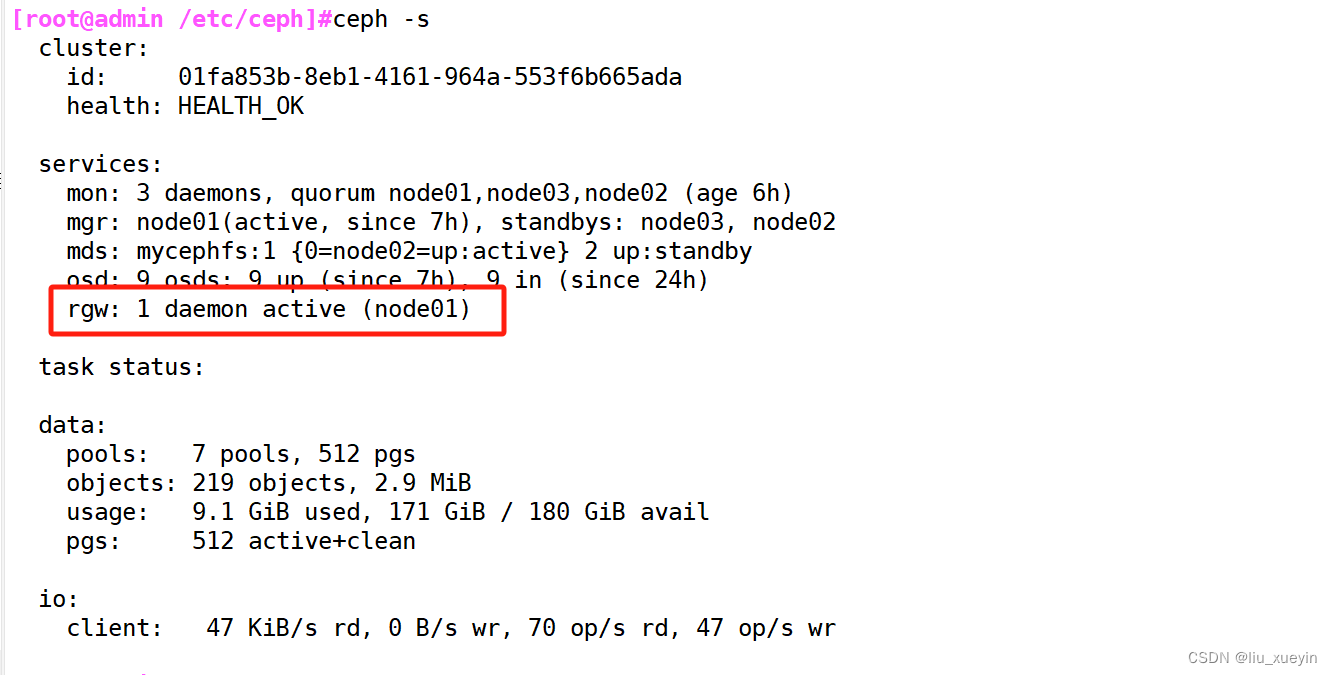
#创建成功后默认情况下会自动创建一系列用于 RGW 的存储池
ceph osd pool ls
rgw.root
default.rgw.control #控制器信息
default.rgw.meta #记录元数据
default.rgw.log #日志信息
default.rgw.buckets.index #为 rgw 的 bucket 信息,写入数据后生成
default.rgw.buckets.data #是实际存储的数据信息,写入数据后生成
#默认情况下 RGW 监听 7480 号端口

//开启 http+https ,更改监听端口
RadosGW 守护进程内部由 Civetweb 实现,通过对 Civetweb 的配置可以完成对 RadosGW 的基本管理。
#要在 Civetweb 上启用SSL,首先需要一个证书,在 rgw 节点生成证书
1)生成CA证书私钥:
openssl genrsa -out civetweb.key 2048
2)生成CA证书公钥:
openssl req -new -x509 -key civetweb.key -out civetweb.crt -days 3650 -subj "/CN=192.168.20.7"
#3、将生成的证书合并为pem
cat civetweb.key civetweb.crt > /etc/ceph/civetweb.pem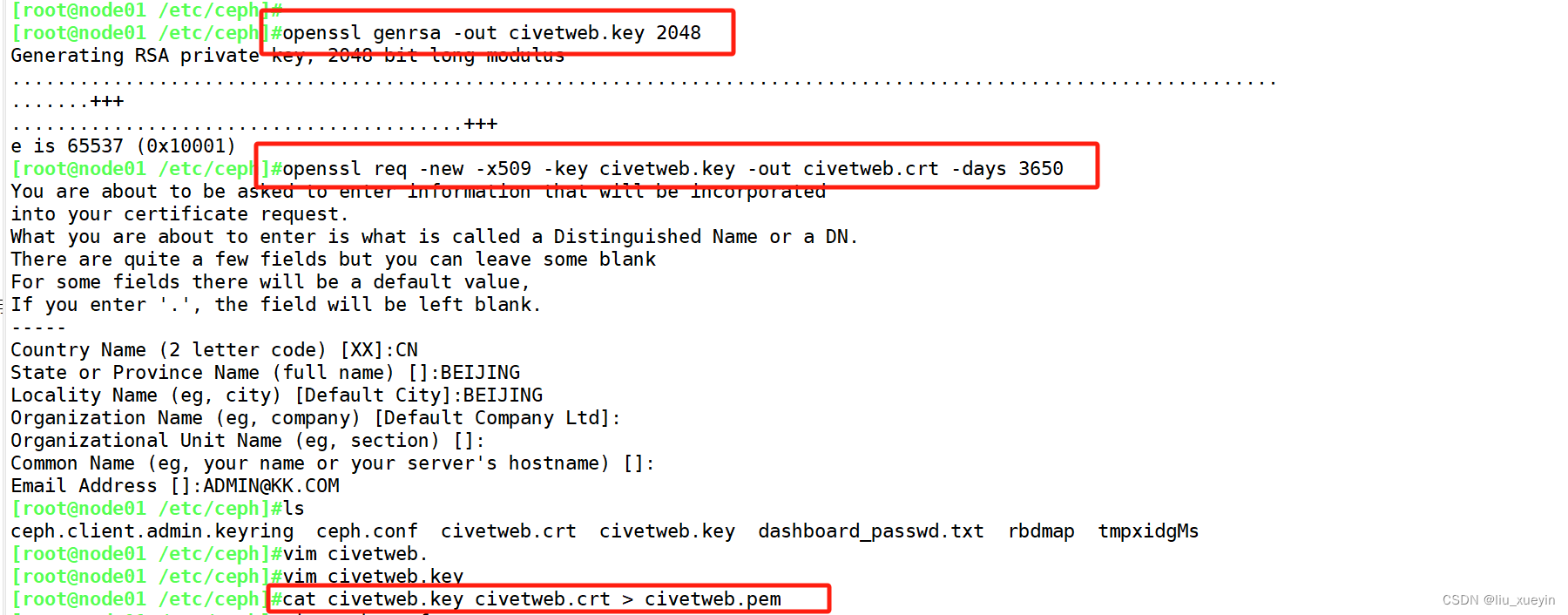
#更改监听端口
Civetweb 默认监听在 7480 端口并提供 http 协议,如果需要修改配置需要在管理节点编辑 ceph.conf 配置文件
vim ceph.conf
......
[client.rgw.node01]
rgw_host = node01
rgw_frontends = "civetweb port=80+443s ssl_certificate=/etc/ceph/civetweb.pem num_threads=500 request_timeout_ms=60000"
------------------------------------------------------------
●rgw_host:对应的RadosGW名称或者IP地址
●rgw_frontends:这里配置监听的端口,是否使用https,以及一些常用配置:
•port:如果是https端口,需要在端口后面加一个s。
•ssl_certificate:指定证书的路径。
•num_threads:最大并发连接数,默认为50,根据需求调整,通常在生产集群环境中此值应该更大
•request_timeout_ms:发送与接收超时时长,以ms为单位,默认为30000
•access_log_file:访问日志路径,默认为空
•error_log_file:错误日志路径,默认为空
------------------------------------------------------------
#修改完 ceph.conf 配置文件后需要重启对应的 RadosGW 服务,再推送配置文件
ceph-deploy --overwrite-conf config push node0{1..3}
systemctl restart ceph-radosgw.target
#在 rgw 节点上查看端口
netstat -lntp | grep -w 80
netstat -lntp | grep 443
#在客户端访问验证
curl http://192.168.20.7:80
curl -k https://192.168.20.7:443
//创建 RadosGW 账户
在管理节点使用 radosgw-admin 命令创建 RadosGW 账户
[root@admin /etc/ceph]#radosgw-admin user create --uid="rgwuser" --display-name="rgw test user"

#创建成功后将输出用户的基本信息,其中最重要的两项信息为 access_key 和 secret_key 。用户创建成后功,如果忘记用户信息可以使用下面的命令查看
radosgw-admin user info --uid="rgwuser"客户端测试

//S3 接口访问测试
1)在客户端安装 python3、python3-pip
yum install -y python3 python3-pip
python3 -V
Python 3.6.8
pip3 -V
pip 9.0.3 from /usr/lib/python3.6/site-packages (python 3.6)
2)安装 boto 模块,用于测试连接 S3
pip3 install boto
3)测试访问 S3 接口
echo 123123 > /opt/123.txt
vim test.py
#coding:utf-8
import ssl
import boto.s3.connection
from boto.s3.key import Key
try:
_create_unverified_https_context = ssl._create_unverified_context
except AttributeError:
pass
else:
ssl._create_default_https_context = _create_unverified_https_context
#test用户的keys信息
access_key = "ER0SCVRJWNRIKFGQD31H" #输入 RadosGW 账户的 access_key
secret_key = "YKYjk7L4FfAu8GHeQarIlXodjtj1BXVaxpKv2Nna" #输入 RadosGW 账户的 secret_key
#rgw的ip与端口
host = "192.168.20.7" #输入 RGW 接口的 public 网络地址
#如果使用443端口,下述链接应设置is_secure=True
port = 443
#如果使用80端口,下述链接应设置is_secure=False
#port = 80
conn = boto.connect_s3(
aws_access_key_id=access_key,
aws_secret_access_key=secret_key,
host=host,
port=port,
is_secure=True,
validate_certs=False,
calling_format=boto.s3.connection.OrdinaryCallingFormat()
)
#一:创建存储桶
#conn.create_bucket(bucket_name='bucket01')
#conn.create_bucket(bucket_name='bucket02')
#二:判断是否存在,不存在返回None
exists = conn.lookup('bucket01')
print(exists)
#exists = conn.lookup('bucket02')
#print(exists)
#三:获得一个存储桶
#bucket1 = conn.get_bucket('bucket01')
#bucket2 = conn.get_bucket('bucket02')
#四:查看一个bucket下的文件
#print(list(bucket1.list()))
#print(list(bucket2.list()))
#五:向s3上存储数据,数据来源可以是file、stream、or string
#5.1、上传文件
#bucket1 = conn.get_bucket('bucket01')
# name的值是数据的key
#key = Key(bucket=bucket1, name='myfile')
#key.set_contents_from_filename('/opt/123.txt')
# 读取 s3 中文件的内容,返回 string 即文件 123.txt 的内容
#print(key.get_contents_as_string())
#5.2、上传字符串
#如果之前已经获取过对象,此处不需要重复获取
bucket2 = conn.get_bucket('bucket02')
key = Key(bucket=bucket2, name='mystr')
key.set_contents_from_string('hello world')
print(key.get_contents_as_string())
#六:删除一个存储桶,在删除存储桶本身时必须删除该存储桶内的所有key
bucket1 = conn.get_bucket('bucket01')
for key in bucket1:
key.delete()
bucket1.delete()
4)按照以上步骤执行 python 脚本测试
python3 test.pyOSD 故障模拟与恢复
1、模拟 OSD 故障
如果 ceph 集群有上千个 osd,每天坏 2~3 个太正常了,我们可以模拟 down 掉一个 osd
#如果 osd 守护进程正常运行,down 的 osd 会很快自恢复正常,所以需要先关闭守护进程
ssh root@node03 systemctl stop ceph-osd@2
#down 掉 osd
ceph osd down 0
ceph osd tree
2、将坏掉的 osd 踢出集群
//方法一:
#将 osd.0 移出集群,集群会开始自动同步数据
ceph osd out osd.0
#将 osd.0 移除 crushmap
ceph osd crush remove osd.0
#删除守护进程对应的账户信息
ceph auth rm osd.0
ceph auth list
#删掉 osd.0
ceph osd rm osd.0
ceph osd stat
ceph -s
//方法二:
ceph osd out osd.0
#使用综合步骤,删除配置文件中针对坏掉的 osd 的配置
ceph osd purge osd.0 --yes-i-really-mean-it
3、把原来坏掉的 osd 修复后重新加入集群
#在 osd 节点创建 osd,无需指定名,会按序号自动生成
cd /etc/ceph
ceph osd create
#创建账户
ceph-authtool --create-keyring /etc/ceph/ceph.osd.2.keyring --gen-key -n osd.0 --cap mon 'allow profile osd' --cap mgr 'allow profile osd' --cap osd 'allow *'
#导入新的账户秘钥
ceph auth import -i /etc/ceph/ceph.osd.0.keyring
ceph auth list
#更新对应的 osd 文件夹中的密钥环文件
ceph auth get-or-create osd.0 -o /var/lib/ceph/osd/ceph-0/keyring
#加入 crushmap
ceph osd crush add osd.2 1.000 host=node03 #1.000 代表权重
#加入集群
ceph osd in osd.2
ceph osd tree
#重启 osd 守护进程
systemctl restart ceph-osd@2
ceph osd tree #稍等片刻后 osd 状态为 up
//如果重启失败
报错:
Job for ceph-osd@0.service failed because start of the service was attempted too often. See "systemctl status ceph-osd@0.service" and "journalctl -xe" for details.
To force a start use "systemctl reset-failed ceph-osd@0.service" followed by "systemctl start ceph-osd@0.service" again.
#运行
systemctl reset-failed ceph-osd@0.service && systemctl restart ceph-osd@0.service





3、把原来坏掉的 osd 修复后重新加入集群
#在 osd 节点创建 osd,无需指定名,会按序号自动生成
cd /etc/ceph
ceph osd create[root@admin /etc/ceph]#ceph osd create
2
[root@admin /etc/ceph]#ceph-authtool --create-keyring ceph.osd.2.keyring --gen-key -n osd.2 --cap mon 'allow profile osd' --cap mgr 'allow profile osd' --cap osd 'allow *'

导入新的账户秘钥
[root@admin /etc/ceph]#ceph auth import -i ceph.osd.2.keyring
imported keyring
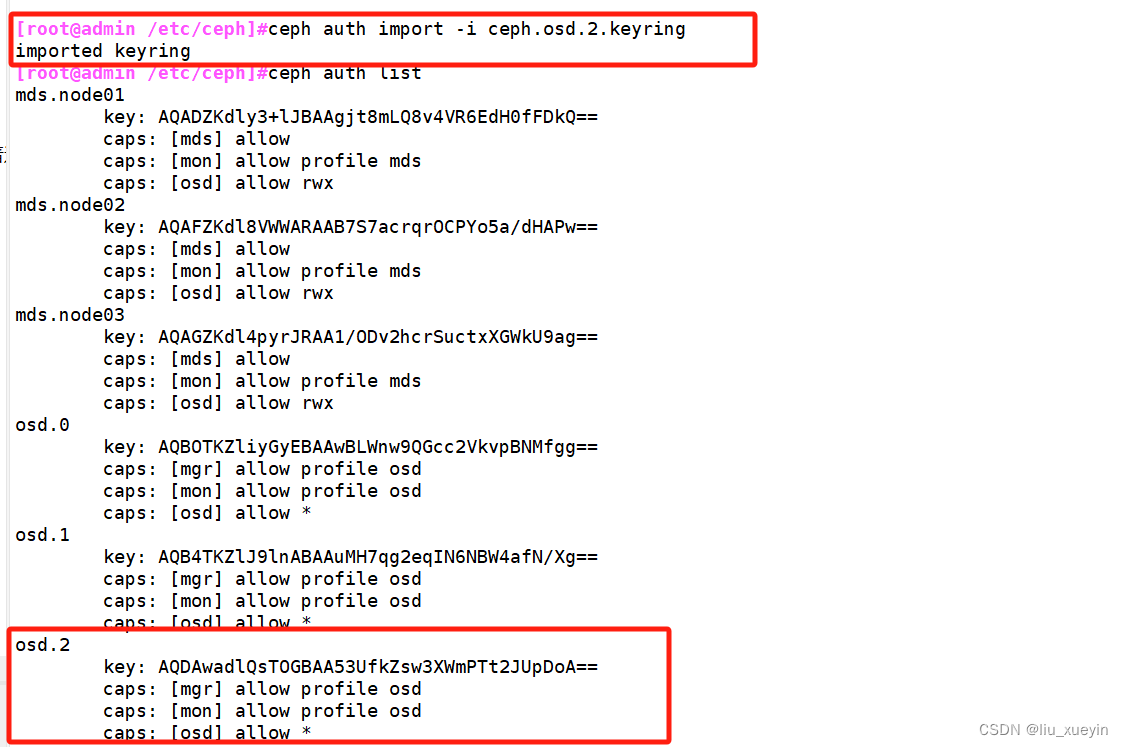


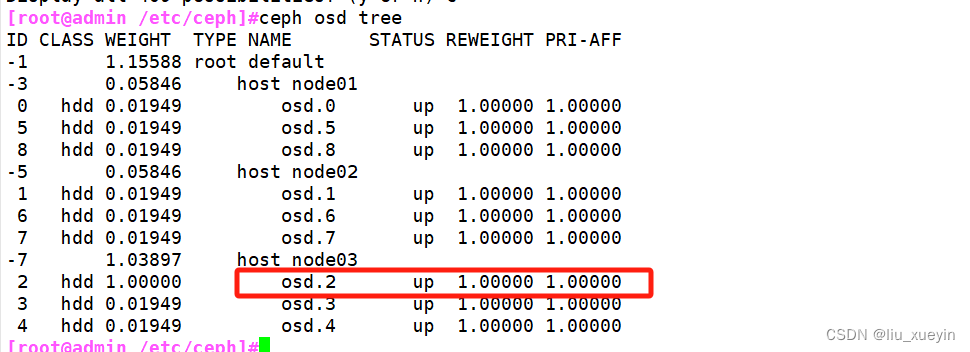
方法二
